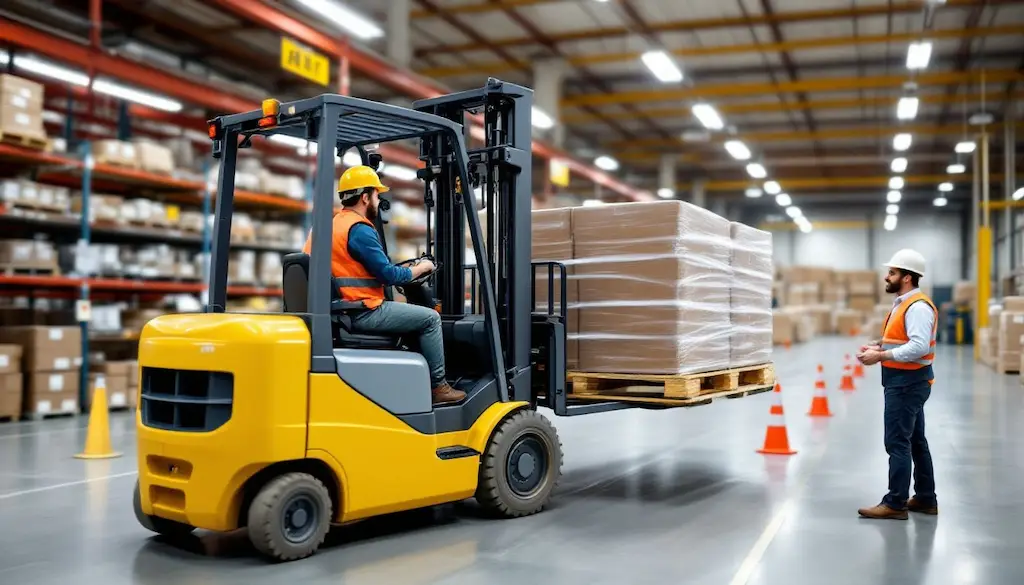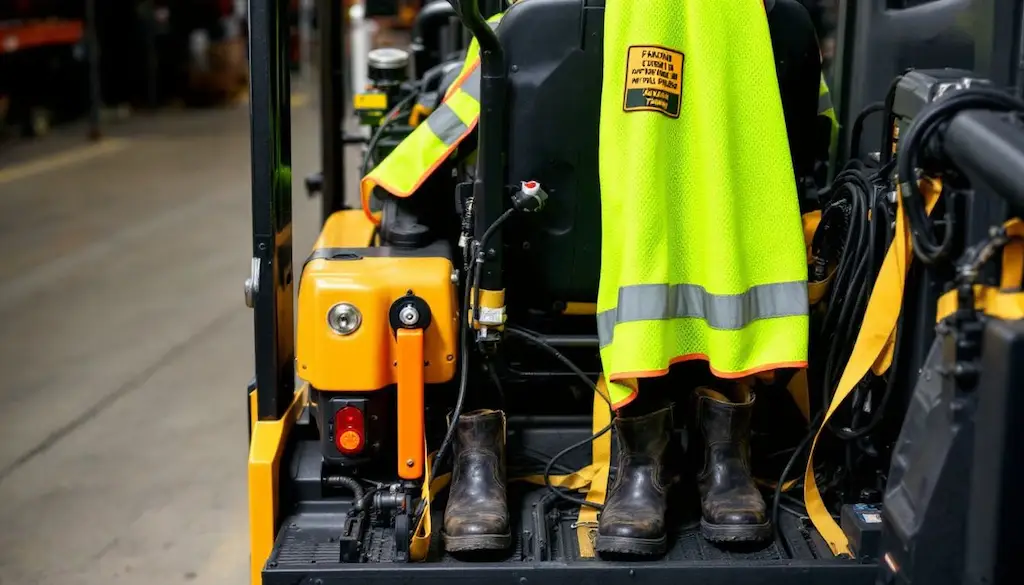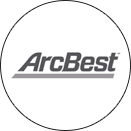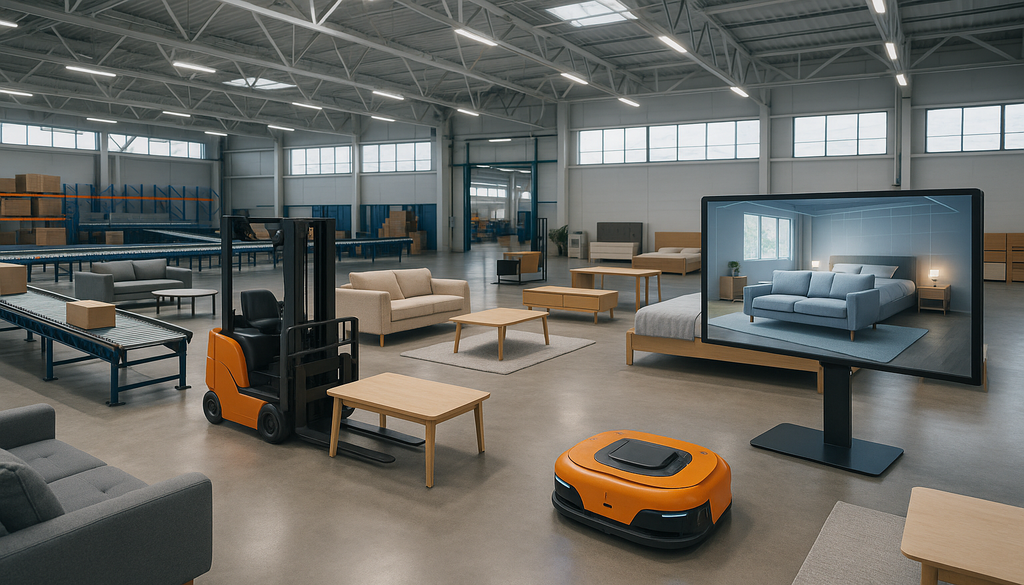Warehouse Forklift Safety Tips for a Safer Workplace
Ensuring warehouse forklift safety is vital to avoid accidents and maintain a productive work environment. This guide covers essential safety practices such as operator training, daily inspections, and safe load handling. Read on for straightforward steps that can help keep your warehouse running safely.
Key Takeaways
- Employers must provide comprehensive forklift operator training that combines theoretical knowledge with practical application to ensure safe truck operation.
- Daily pre-shift inspections of forklifts are mandated to identify and address potential issues, which helps prevent accidents and maintain a safe workplace.
- The use of personal protective equipment (PPE) and adherence to safety protocols, including proper load handling and awareness of surroundings, are essential for reducing risks and enhancing safety in warehouse environments.
Comprehensive Forklift Operator Training
Safety starts with knowledge. Employers must create a training program that adheres to OSHA standards and focuses on safe truck operation principles, including OSHA forklift safety rules. This isn’t just about ticking boxes—it’s about equipping forklift operators to train employees with the skills and awareness needed to handle heavy equipment safely.
An effective training program combines formal and practical methods. Classroom instruction provides a theoretical foundation, while hands-on training allows operators to apply what they’ve learned in real-world scenarios. This dual approach ensures that operators are well-versed in both the mechanics and the nuances of forklift operation.
Certification marks the beginning, not the end. Performance evaluations are necessary to confirm competence. Refresher training becomes essential when operators display unsafe practices or switch to a different forklift model. Each forklift has unique features and handling characteristics, requiring specific training to prevent accidents.
Daily Forklift Inspections

Imagine starting your shift only to discover mid-operation that your forklift’s brakes are faulty. To prevent such scenarios, OSHA standards mandate a daily pre-shift inspection of powered industrial trucks. These inspections are crucial for identifying and addressing minor issues before they escalate into serious safety concerns.
A thorough pre-shift inspection should include checking critical components such as tires, brakes, steering, lights, and safety features. Additionally, equipment operation, attachments, maintenance status, and fuel/charge levels should be assessed. These checks ensure that the forklift is in optimal working condition, ready to handle the day’s tasks safely.
Any issues found during inspection should be reported to a supervisor immediately. This proactive approach prevents potential accidents and enhances overall safety. Regular checks and prompt reporting are key to maintaining a safe warehouse safety environment.
Personal Protective Equipment (PPE)
Personal protective equipment (PPE) plays a critical role in workplace safety. Forklift operators should wear appropriate PPE to protect against various hazards. Hard hats guard against head injuries from falling objects or potential overturns.
High-visibility vests ensure forklift operators and warehouse workers are easily seen by other employees and machinery operators, which is essential in busy warehouses. Steel-toed shoes protect against heavy loads and potential chemical hazards.
PPE significantly enhances workplace safety and occupational safety by reducing the risk of physical injuries. Employers should enforce PPE use and ensure all operators are equipped with the necessary gear.
Awareness of Surroundings
Operating a forklift demands constant vigilance. Being aware of surroundings is crucial to avoid accidents. Operators should stay mindful of pedestrians and other vehicles nearby while operating forklifts, helping to prevent collisions.
Auditory signals like horns and visual aids such as lights can significantly improve visibility. Effective signage, including stop signs and directional indicators, further enhances safety by ensuring everyone is aware of each other’s presence.
In areas with low visibility, operators should exercise heightened caution and give way to pedestrians. At blind corners and intersections, using the horn to alert others is crucial. Additionally, checking for adequate overhead clearance before lifting loads ensures safety.
Adhering to Speed Limits and Load Capacities
Speed can be a silent killer in warehouses. Adhering to speed limits prevents accidents, tip-overs, and loss of control. New operators should maintain a controlled speed of 3-5 mph, allowing ample time to react to unforeseen obstacles.
The stability and maneuverability of forklifts can be affected by uneven terrain, weather conditions, and varying surfaces, which can lead to forklift tipping. Operators must be mindful of these factors and adjust their speed accordingly.
Maintaining the recommended load capacity is crucial to prevent tipping and ensure safe operation.
Smooth and Controlled Operation
Smooth and controlled operation marks a skilled forklift operator. Sudden jolts or abrupt movements can destabilize loads, leading to accidents. Maintaining a steady pace helps avoid sudden shifts and load instability.
Slow and careful movements minimize the risk of accidents and enhance overall safety. Operators should control their speed, especially in tight spaces, to maintain control. Smoothly utilizing accelerator and brake pedals ensures safer load handling.
Safe Load Handling Practices

Proper load handling is vital for forklift safety, preventing accidents and maintaining a safe working environment. Balancing and securing loads before lifting prevents accidents. Loads should be centered to avoid instability, and positioning the heaviest part near the front wheels enhances stability.
Securing loads to avoid shifting or falling during movement is crucial. Operators should be cautious with off-center loads to mitigate tip-over risks. Lowering loads to about 6 to 8 inches above the floor adds an extra layer of safety.
Prohibiting Horseplay
Horseplay has no place in a warehouse. Engaging in roughhousing diverts focus from tasks, increasing accident likelihood. Safety protocols explicitly forbid horseplay due to its inherent risks and potential for serious injuries.
Fostering a safety-first culture helps minimize hazards and ensure a safer work environment. Employees must adhere to safety procedures and avoid behaviors that could lead to safety risks, property damage, or injuries.
Proper Use of Parking Brake

Engaging the parking brake is a simple yet crucial safety measure, preventing forklifts from rolling, particularly on slopes. OSHA guidelines specify that any unattended forklift should have the parking brake fully engaged to prevent potential accidents.
Operators should make it a habit to engage the parking brake whenever the forklift is left unattended. This practice is a fundamental aspect of forklift safety and contributes to a safer work environment.
Reporting Incidents and Near-Misses
Reporting incidents and near-misses is crucial for improving safety culture. Operators witnessing a near-miss should report it to their supervisor immediately. This allows for investigation, corrective actions, and measures to prevent future occurrences.
Neglecting to report incidents can lead to accidents, injuries, and property damage. Proper training is necessary to control forklift accidents rates with forklifts. Injuries from forklifts account for 10% of all physical injuries within warehouses, highlighting the importance of safety training.
Vigilance and commitment from operators are crucial in preventing accidents and injuries. A proactive approach to reporting and addressing potential safety hazards and implementing safety measures ensures a safer work environment for everyone.
Summary
In summary, forklift safety is a multifaceted approach that requires comprehensive training, daily inspections, and adherence to safety protocols. By equipping operators with the necessary knowledge and tools, we can significantly reduce the risk of forklift accidents and create a safer work environment.
Personal protective equipment, awareness of surroundings, and proper load handling practices are just a few of the essential safety measures that contribute to workplace safety. Engaging the parking brake and prohibiting horseplay are simple yet effective steps in maintaining a safe warehouse.
Remember, safety is everyone’s responsibility. By implementing these forklift safety tips, we can foster a culture of safety and ensure that every employee goes home safe and sound at the end of the day.
A Safer Warehouse Starts with Smarter Operations
While safety begins on the warehouse floor, it’s strengthened by efficient, well-managed systems. Cadre Technologies’ warehouse management software solutions help you streamline operations—from receiving and inventory management to order fulfillment and labor reporting—so your team can stay focused, productive, and safe.
Discover how better visibility leads to better outcomes. Explore our cloud-based WMS.
Contact us today to learn more.
Frequently Asked Questions
What is the three point contact rule for forklifts?
The three point contact rule for forklifts emphasizes maintaining three points of contact when getting on or off the truck to ensure safety. This practice is crucial for preventing falls and ensuring stability.
What are the safety rules for forklifts in a warehouse?
To ensure safety while operating forklifts in a warehouse, maintain clear visibility, ensure sufficient clearance when maneuvering, and use horns in potentially obstructed areas. Always be aware of pedestrians and adhere to speed limits.
Why is forklift operator training important?
Forklift operator training is crucial because it equips operators with the necessary skills to operate safely, thereby minimizing the risk of accidents and injuries in the workplace. Proper training not only protects employees but also enhances overall operational efficiency.
What should be included in daily forklift inspections?
Daily forklift inspections should include checking critical components like tires, brakes, steering, lights, and safety features to ensure optimal working condition. Thorough inspections are essential for safe operation.
Why is personal protective equipment (PPE) necessary for forklift operators?
Personal protective equipment (PPE) is essential for forklift operators as it safeguards against numerous safety hazards, enhancing overall workplace safety. Using items like hard hats, high-visibility vests, and steel-toed shoes is crucial for operator protection.










